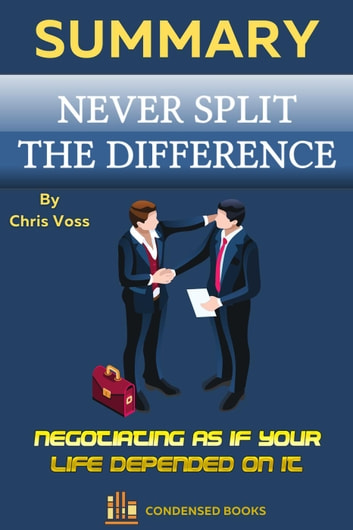Table of Contents
Never Split the Difference Summary
A high-quality summary of Chris Voss´s book Never Split the Difference including chapter details and analysis of the main themes of the original book.
About the original Never Split the Difference book:
A veteran FBI hostage negotiator proposes a new, tried-and-true method of bargaining that works in every scenario.
After a time police the harsh streets of Kansas City, Missouri, Chris Voss joined the FBI, where his job as an abduction negotiator brought him face-to-face with bank robbers, gang leaders and terrorists. Never Split the Difference takes you inside Voss’s world of high-stakes negotiations, exposing the nine crucial principles that helped him and his colleagues win when it really counted — when people’s lives were on the line.
Never Split the Difference is based on the real-life experiences of an intelligence expert at the top of his game, and it will offer you a competitive advantage in any conversation.
Never Split the Difference Summary is written by Peter Cuomo.
Never Split the Difference Plot
Never Split the Difference: Negotiating Like Your Life Depends on It is a nonfiction book authored by Chris Voss, an international hostage negotiator turned business consultant and academic, journalist Tahl Raz in 2016.
Voss discusses concepts acquired from decades of experience in high-stakes negotiations in this book that straddles the border between the business and self-help genres.
The citations in this guide relate to the Harper Collins first edition. Although Raz is listed as a collaborator, the book is written in first person from Voss’s perspective, therefore the authorial intent in the summary sections of this guide refers to Voss.
Never Split the Difference is organized into ten chapters, each of which begins with a tale that illustrates the chapter’s primary subject and ends, except the first, with a bulleted summary of the chapter’s essential points.
Voss begins Chapter 1 with a tale, which leads to a discussion of traditional and academic methods to negotiation, as well as the emotional awareness that distinguishes Voss’s approach. Mirroring is introduced as a fundamental approach for collecting information from the opposite side in a negotiation in Chapter 2.
The third chapter emphasizes the importance of categorizing emotion as a means of overcoming obstacles to achievement. The emphasis in Chapters 4 and 5 shifts to obtaining and evaluating the most important replies from a negotiation partner, such as «no» and «that’s right,» respectively.
The following chapters provide specific advice on how to influence the psychological state of the individual with whom you’re negotiating. In Chapter 6, you’ll learn how to redefine what’s fair and practical in a negotiation to achieve your goals. In Chapter 7, you’ll learn how to persuade your rivals closer to your solution while giving them the impression that they’re in charge.
Chapters 8 and 9 provide directions for ensuring that plans are carried out once they have been agreed upon, as well as techniques for winning in head-to-head negotiations.
Voss shifts to a more theoretical tone in the last and longest chapter. He emphasizes that black swans, or unknown bits of information that, if uncovered, might completely change the course of a negotiation, can be located everywhere.
He gives tips on how to find and use such crucial data pieces, then finishes by encouraging readers to face their anxieties and embrace negotiating.




